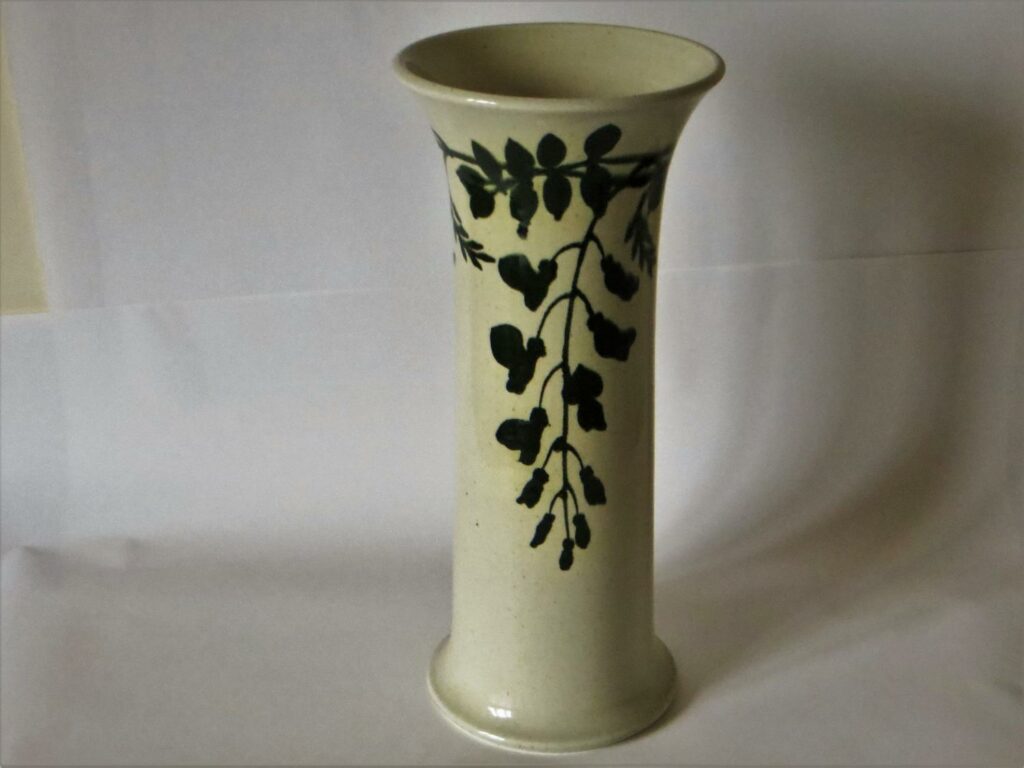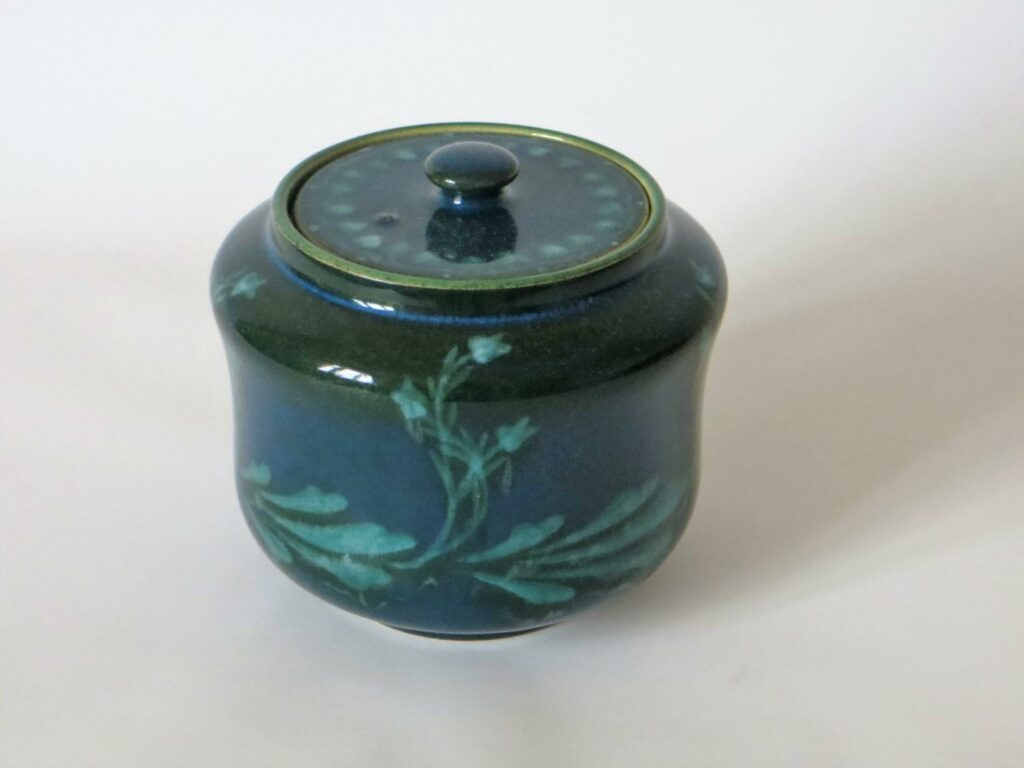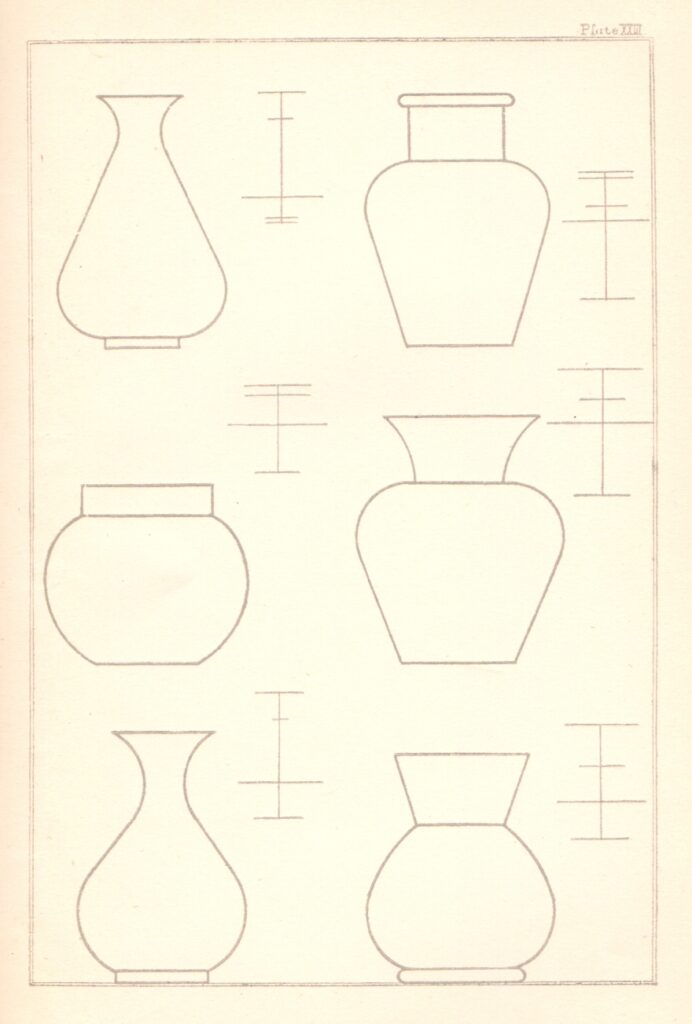Designs and Shapes
Designs
Some of the earliest Ruskin Pottery souffle glazed items have decoration. Several of the pieces submitted to the V&A museum in 1901 are decorated. The firm’s 1905 catalogue stated that when pattern was used it was hand painted and kept subordinate, no attempt being made to be painted realistically, flowers, landscapes or figures. The standard early vase shape 101 often has a circling band of tall Colts foot stems and other small items, vases, ink pots and scent bottles have designs of water Lily pads, Lily of the Valley, fruiting vine or trailing vine, Wisteria, Devil’s ivy and berried ivy. Table wares have rims decorated with bands of leaves with small flowers or berries. There are many variations on the theme of leaf garlands or interlocking leaves and one design has a circle of such leaves with tall plant stems growing from them bearing small bell-like flowers.
Most of the souffle designs were not carried forward to the lustre wares which began to appear in 1906. Many of the yellow and orange lustres of the period are decorated, most often with the fruiting or trailing vine designs. Few new designs appear until two elaborate schemes were introduced, thistle and flowering grasses, beginning in the 1910-1912 period. Decoration on lustres was discontinued in 1921.
There were problems in applying the design to specific coloured glazed backgrounds; over firing would cause the design to slip. The yellow and orange glazes seemed to develop well because the design was put onto a white slip before the colour was applied. Orange, yellow and rarer green were all prone to rubbing.
William Howson Taylor tried many ways of working around this problem of ‘design slip’. One way was to cut out the design in the clay state and then fill it in with glaze. Applying the design over the glazed vase or scratching the design before glossing were also attempted, but these are rare.
As part of the new style Howson Taylor began to develop from 1926 some new decorative ideas were tried; moulded Tudor roses or Celtic-style knots were attached to vases, tube-lined stems with moulded flowers encircle some larger shapes and on a few vases and bowls incised decoration was tried. In the 1928-29 period a distinctive scheme of tube-lined foliage in purple enamel on a turquoise souffle ground was new as was a band of moulded small six petal flowers.
Shapes
The shapes of Ruskin Pottery are well represented in the series of catalogues and postcards issued over it’s lifestime. There is some evidence that it was Edward Taylor who was responsible for desgining and developing the early shapes. In his 1890 book ‘Elementary Art Teaching’, he considered the question of proportion in relation to pots and as illustration he selected some vase forms, several of which became the basis of shaped introduced by the pottery. Similar simple but well-proportioned examples are shown in Ruskin’s early ‘Forms in Pottery’ pamphlet where it is stated that they were handmade on the potter’s wheel under Mr. Taylor’s supervision. Twenty-two vase and bowl shapes were illustrated designed by Edward Taylor and they form the basis for the production of the 1900-1904 period. By the time of the catalogue issued in 1905, the number had increased to 255 and the range was further extended in about 1906 to 326, though some thinning out was already beginning and a lot of the shapes are not known in an example. Further additions in a catalogue of about 1909 take the number up to 353, though many more had been deleted. After Edward Taylor’s death in 1912, W. Howson Taylor issued a new catalogue with two colour plates and thirty black and white plates, which showed a selection of vases, bowls and caddies taking the number up to 440. These became the standard items of production for a decade.
Ruskin developed a new range of footed shapes to go with the new lustre glazes of the 1920s and issued a set of post cards illustrating the designs. The next change in style resulted in the production of a promotional folder showing the new Art Craft “A” shapes issued in 1928 followed by a number of coloured postcards at the end of the decade which featured the moulded geometric pieces being introduced. No more promotional material was produced before the closure of the pottery in 1933 so nothing is known relating to the range of lamp bases or the late decorative jugs. The Ruskin shapes of the pre-war period are often said to be Chinese in their inspiration but in fact only twelve of the 255 in the 1905 catalogue relate to Chinese examples though many share the style and proportion of the Chinese classic wares. Like the Chinese, the Ruskin are not subject to the vagaries of fashion and a century on appear timeless. The Art wares adopt, but do not copy, the style of Ancient Egypt and it is only the moulded geometric pieces of the late 1920s which now seem dated.







Hello
I have a sky blue footed bowl, 8.75cms in diameter and about 9.5 cms tall, in iridescent glaze, impressed on the base RUSKIN England. I would love to know how old it is and whether it was hand thrown? I used to work for Wedgwood and have a love of pottery and have enjoyed looking at you website.
I know that Britain stopped using the word ‘England’ at a certain date on pottery but cannot find out just when this was…..can you help me date the bowl please?
Thank you. I look forward to hearing from you.
Margaret Gould
I look forward to a reply
Hi Margaret,1928-29 Ruskin pottery never dated their ware and only stamped the ware Ruskin England so your bowl falls into these years and was hand thrown ,thanks for contacting me John
Hello! I have a ruskin vase in a speckled green with 1915 England on the bottom. there looks like there may be a 1 on it. Do you have any information on this piece? Thanks for any information you can give.
I see with the pictures above what the 1 means. I didn’t see that prior to writing the post
Hi Marjorie,by your description it sounds that it’s a souflee glazed vase ,1915 had these glaze’s on a brown pottery body .The 1 mark does not relate to’ the forms in pottery ‘numbering, as this was only done between 1898-1902,thank you
Could you tell me what my 1921 blue tall vase is please
The vase is 1921 blue quite large but no idea of value or style
Hi Colin,,if the vase is shiny then it’s a lustre vase ,popular colour of the 1920s.Value depends on condition,if it’s sound then £100-200 shape is also a factor,thanks for looking on the site
I have a vase marked Ruskin Smethwick 1906 which I think might be the year it was made rather than a shape number. Also has the scissor mark. Pink background with blue grey leaves flowers which cascade from the top of the vase. MEASURES 6.5″tall.
In Good condition.
Hi Ann ,yes 1906 is the date it was thrown the painted scissors is implying that it’s had paintwork to the body and also the reference to the manufacturer ‘Taylor ‘ Pink background with grey design came in souflee and lustre glazes very attractive
Thanks for the reply. Any idea how much it would be worth? I think I’ve had a bargain as I bought it in a charity shop for £4.00.However I’ve looked everywhere and can’t find anything similar.
Considering that the vase is perfect l would say £100-130 it also depends on the shape of the item too ,well done
Hello,
On the bottom of my yellow lustre vase it is marked “916P”, at least it looks like a “P” after the number. Are you able to tell me what that refers to? Many thanks, I have enjoyed reading all of your information.
Michael
Thank you for the compliment Michael Without looking at it I’m guessing but I would say your reading it the wrong way and it should read 1916 ,will contact you and maybe you could provide a image .l love to see something new!
Hello,
I have recently acquired a Ruskin Pottery Vase. Thank you for the help your site has provided.
It is a blue souffle with lilac waterlily decoration in shape 8/9. To the base is a lilac scissor mark only.
I have pictures ready if you would be interested to see these. I’d like to find more information about
it and see what you think.
Many Thanks and Regards.
Gill
Thanks for the images Gill truly a lovely early vase, shape 8 from the forms in pottery on a tocky body with the water lily design,great collectors piece
I have a Ruskin brooch, it is round with an uneven ‘silver’ surround and is backed by a hinged mirror which opens on to the back of the pottery stone. May I send you a photo ? I would love to know the approximate date, it feels very Arts and Crafts
Love to see it Norma,thanks
What is the email address ? Ive tried sending to Ruskin.org no luck !!